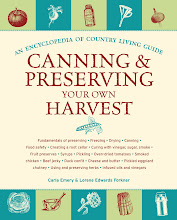Along with the few scattered days of sunshine come my cravings for anything fresh and green. Whether I am picking the last of my winter greens, with their characteristic sweetness from the cold, or just planting my spring lettuces, I just can't get enough of them. Greens were perhaps one of the last vegetables that I acquired a taste for (second only to beets), and now I eat them with most meals, sautéed in butter and folded into an omelet, or simply tossed with a few other ingredients into a salad.
Harvesting
There are 2 different ways: by cutting off the whole plant about 2 or 3 inches above the ground, and by picking only the outside leaves and leaving the center ones to develop. If you cut off chard, endive, lettuce, mustard, and spinach the first way, they'll grow back just like grass. But for collards, kale, and New Zealand spinach, you must do it the second way. Take those outer leaves by cutting with a scissors or snapping them off by hand. If you keep up with them, you'll keep the outer leaves tender. If they get ahead of you, the outer leaves are likely to get tough. In that case, give them to chickens, cows, etc., and go in an- other layer to get the now-tender ones.
Cooking
Which greens to eat cooked is really a matter of opinion. Some people eat anything and everything raw. Some greens you can eat raw at one stage or in small amounts, but at maturity (or over-maturity!) or in quantity you'll definitely want to cook them. An advantage of cooked greens is that you can preserve them by canning, freezing, or drying. To cook greens, first wash your leaves. Boil with or without salt. To add flavor, use water in which meat or vegetables have been cooked. Or serve buttered and peppered. Or with vinegar. Or season with bacon drippings, salt, and hot sauce. Mustard, kale, and turnip greens are specially good cooked in the water in which the meat has cooked and then served with the meat.
Preserving
Step-by-Step Greens Freezing
1. Wash off bugs and dust from leaves. Put a big pan of water on to boil. (I bring greens into the house by the 5-gal. bucket.)
2. Cut in lengths of about 21⁄2 inches.
3. Drop a load of greens into the boiling water. Let boil 3 minutes. (You can also blanch by steaming or even stir-frying!)
4. Scoop greens into a colander to drain. (I fish the greens out of the water using 2 potato mashers, the same way I do corn on the cob, one masher on each side.)
5. Hold under running cold water just long enough so that you can handle them. Or cool (immediately!) in ice water.
6. Pack in baggies, squeeze out most of the air, and fasten the neck with one of those little wires or tie it in a knot. Pack enough chard in the baggie for 1 meal for your family.
7. Immediately put in the freezer.
8. When you want to eat frozen greens, just turn out the frozen lump into a little water. Thaw and heat. Either butter them or serve them with vinegar.
Canning Loose-Leafed Greens.
It is safer and tastier to freeze greens than to can them. If you do can, you must use a pressure canner. Choose fresh, tender greens. Wash and cull out bad leaves. Remove tough stems and midribs. Make sure you have rinsed away all the dirt. Blanch by steaming, briefly boiling, or stir-frying until wilted. Loosely pack hot greens into hot jars. Optional: Add 1⁄4 t. salt per pint, 1⁄2 t. per quart. Pour over enough boiling water to cover, but leave 1 inch headspace. Process in pressure canner: pints 70 minutes, quarts 90 minutes. If using a weighted-gauge canner, set at 10 lb. pressure at 0-1,000 feet above sea level; at higher altitudes, set at 15 lb. If using a dial-gauge canner.








No comments:
Post a Comment